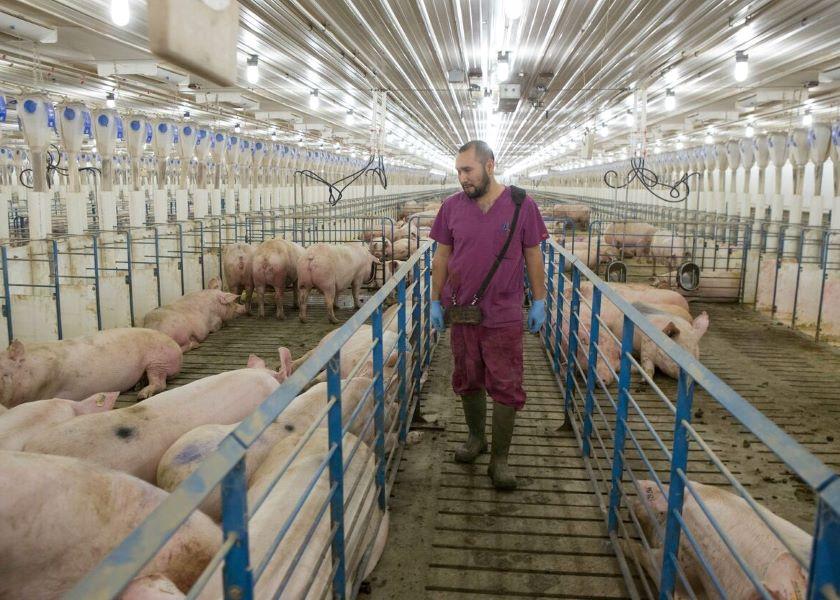7 Things You Need to Know Before Hiring Workers from Mexico

The average annual income in Mexico is $6,671. In the U.S., it’s $60,220. The risk of poverty in Mexico is 41.9%, whereas in the U.S. it’s 11.4%. The rate of homicides per 100,000 people in Mexico is 28.74 versus 4.99 in the U.S., shared Victor Ochoa of Swineworks during a presentation at the Ohio Pork Congress.
It’s no wonder why the U.S. is an appealing place to work, and the TN visa program with Mexico is intriguing to U.S. farms looking for more labor. As entry-level off-farm positions in the U.S. increase to up to $23 an hour at places like Amazon and Walmart, it becomes harder and harder to fill the growing vacancies on farms today.
The TN visa program, which requires a minimum of a bachelor’s degree and is open to professionals in Canada and Mexico, is one of the reasons why Caleb Shull, director of research and innovation for The Maschhoffs, is optimistic about the challenging labor situation in the U.S. pork industry.
“We have a great opportunity to benefit from the influx of talented people through the TN visa program,” Shull says. “We have made significant strides in getting closer to full-staffed farms because of the TN visa program. The individuals participating in the program are educated and have a hunger to learn and a desire to impact our industry.”
Production systems that invest in bridging the language and culture gaps will be rewarded, Shull points out.
Before systems can truly accomplish bridging this gap, Ochoa says it’s important to consider the differences between the culture in the U.S. and the culture in Mexico.
“Through my career as a farm manager, I’ve seen many of my TN visa employees struggling to adapt to the American culture. It is not just adapting to different food, weather or language, but to a different mindset that can have a larger impact in their career and quality of life. At the same time, employers fail to recognize these differences over and over again, and start wondering why their TN programs are not that effective,” says Ochs, born in Mexico City and came to the U.S. through the TN visa program.
Here’s a look at seven cultural differences that help foster a workplace that is not only inviting for employees from Mexico to join, but is also a workplace they won’t want to leave.
1. Law enforcement
“We have a lot of laws in Mexico, but there is nobody to enforce them,” Ochoa says. “If you do get caught by a cop and you have money, you are fine. But we all know that’s not the case in the U.S.”
That’s why Ochoa says it’s important to have an onboarding program that helps employees understand some of these differences. Set the expectations straight with them, Ochoa adds.
2. Animal welfare
Animal welfare concepts in Mexican culture are fairly new, especially in animal production, Although Ochoa says animal welfare has gotten better over the last few years in Mexico, it’s not yet a priority. He urges employers to help their Mexican employees understand basic animal welfare principles to ensure the best care is provided to the pigs.
“Some things we consider common sense, like not kicking an animal or not throwing the piglets, is not common sense for the culture in Mexico,” he says. “Train them to understand why animal welfare is important.”
3. Public transportation
Unlike Mexico where there is a lot of public transportation, most rural areas in the U.S. don’t offer public transportation options for workers.
“In Mexico, we have a lot of public transportation, so people don’t need to know how to drive or own their own vehicle,” Ochoa says. “When you are recruiting employees, make sure you find somebody who knows how to drive, and let them know they need to start saving money so they can purchase a vehicle and gas money.”
4. English language
“We always get asked, ‘Can they speak English?’” Ochoa says. “That’s a good question. Only 10% of our applicants in the TN visa program speak the language.”
With the very low unemployment rate of 4.2% in Mexico, finding a worker with a degree who speaks English is going to be challenging, Ochoa points out. It’s unlikely they are going to be looking for positions on a pig farm.
“It’s going to be very hard to find somebody who's fully bilingual,” he says. “But, because they have a college education, they are very exposed to the language through the movies and assignments in school where they have to read a lot in English. Even though many cannot speak and communicate in English, they are able to read and be familiar with a lot of the words. So, English is not a completely strange language to them once they get here.”
5. Communication and conflict avoidance
Communication and avoiding conflict go hand-in-hand when onboarding new employees from Mexico, according to Ochoa.
“I have heard many stories about employers who explain instructions to a worker from Mexico and they nod their head that they understood,” Ochoa explains. “And then, the worker goes and does the opposite.”
Although an employee might nod yes and seem to understand, always follow up with them. A new employee isn’t going to want to ask too many questions or come off as arguing with a new employer, he says. Make sure you communicate well with your employees.
6. Family
One of the most important things an employer can understand about Mexican culture is that it’s very family-oriented, Ochoa says. Don’t miss this important cultural difference when you consider how to onboard new employees.
“Create a culture in your farms where you celebrate birthdays, marriage and more. We use everything as an excuse to celebrate,” he says. “I would recommend you create that environment on your farms because it’s going to help them feel more welcome and want to stay longer.”
7. Housing
Even though housing is not required under the TN visa program, Ochoa says employers need to keep in mind that employees do not know the area and come with very little money saved. It will take time get a social security number to secure a house. For these reasons, he recommends providing some sort of housing during the onboarding period – a place that is safe and clean, he advises.
Don’t move forward with an international staffing program until you’ve considered how you can bridge the gap between the cultural differences between the U.S. and Mexico. It’s too late to develop a plan when your new employees arrive.
Read more:
What’s Driving the Pork Industry in 2023?
5 Pig Farmers Share Top Takeaways from Ohio Pork Congress
Away from the Spotlight: Seger Speaks Up About Leading Ohio Pig Farmers
Pork Producers Open Up About Technology, Labor, Foreign Animal Disease and More







